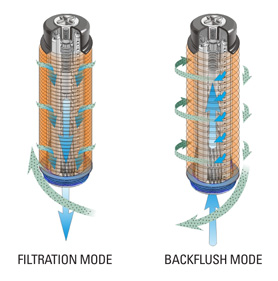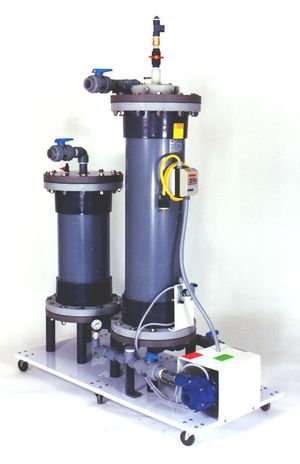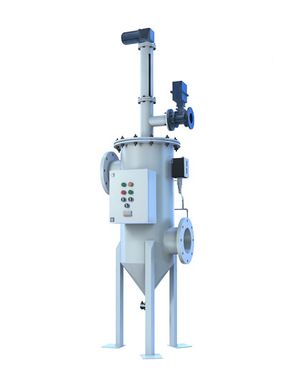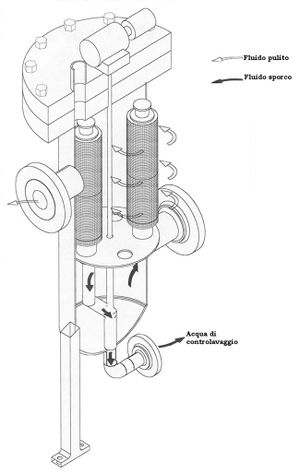Difference between revisions of "Backflush Filters"
| (One intermediate revision by the same user not shown) | |||
| Line 11: | Line 11: | ||
[[File:Backflush_filters_03.jpg|thumb|right|Backflush]] | [[File:Backflush_filters_03.jpg|thumb|right|Backflush]] | ||
[[File:Backflush_filters_04.jpg|thumb|right|Backflush Model]] | [[File:Backflush_filters_04.jpg|thumb|right|Backflush Model]] | ||
The '''backflush filter''' is used as pressure filter in the main flow and in a hydraulic system has the function of filtering and removing the contaminants of a hydraulic fluid. These contaminants mainly occur in the form of metallic abrasions, lacquer, rubbed off seal parts, dust, and scales. When no backflush filters are installed these dirt particles are taken to all points of a hydraulic system and can thus impair the functional reliability of the system. The backflush filter consists of the filter housing, the filter elements, and the control components. | |||
==Features== | |||
*Used in industry | |||
*Continuous filtration supports rational production processes | |||
*Large filter surface area due to 2-cylinder filter elements | |||
*Low backflush flow rates and optimal cleaning of the filter element improve filtration efficiency | |||
*Perfect synthesis of ecology and economy | |||
*Mature engineering and robust design | |||
*Compact design | |||
*Filter ratings from 25 to 1000 μm absolute, other ratings on request | |||
*Easy to service | |||
== | ==Operating principle== | ||
-The filter housing contains two filter elements with pleated wire cloth cylinders through which the medium flows and contaminants are trapped on the inside of the element. | |||
The | -When a defined differential pressure is reached or after a settable time interval, the fully automatic backflush process starts. | ||
-When the backflush start time is reached, first of all one of the flush valves opens and the gear motor starts to turn the external filter element. Thereby the whole filter surface bypasses the cleaning nozzle. | |||
-The process medium that has already been filtered flows at high speed in the opposite direction through the vertical slot, which is located directly on the filter element. The trapped contaminants are discharged from the system via the flush pipe. | |||
-The flush valve closes when the filter element has been turned approximately 400° and the second flush valve opens in order to clean the internal filter element similarly. Afterwards the gear motor is switched off and the flush valve closes again. The backflush process is completed in only a few seconds. | |||
-Since the element is turned, only the part covered by the cleaning nozzle is actually cleaned; the remainder can continue to be used for filtration ® operation is not interrupted. | |||
==Steps of Backflushing== | |||
The necessary steps are described in the following: | |||
-The filter comprises a bowl with a cover and a gear motor. | |||
-The bowl contains a vent port, a drain port and a filter element. | |||
-The filter must be filled and vented before it is put into service. It must not be operated with the full pump flow when empty. | |||
-Switch on the filter controller and start a flushing process with the hand release. If the viscosity of the medium is very sensitive to temperature, the filter controller should not be switched on until the filter reaches its normal service temperature. | |||
-The filter controller must be switched off if the plant is not in service. | |||
-In order for the backflushing process to be efficient, there must be operating overpressure during the flushing process on the outlet side of the filter. | |||
-Backflushing starts automatically after a defined time or when the maximum differential pressure is reached. If the differential pressure exceeds 3 bar, the filter must be removed from service or changed over to bypass. Then dismantle the filter and clean the wire cloth cylinder (refer to "Cleaning"). | |||
-When a flushing process is tripped, the gear motor is switched on and a flush valve for the flushing medium outlet opens. The medium flows from the clean side through the filter element and into the internal nozzle as the element is turned by the gear motor. | |||
-After turning approximately one time the first flush valve closes and the second one opens. As the filter element is still turned by the gear motor, the second filter element is cleaned. | |||
-The flushing medium flows through the wire cloth at high speed, so that the contaminants trapped in the filter are detached and discharged via the flushing outlet and the flush pipe connected to it. | |||
-The filter controller is programmed so that the flush valves close again and the gear motor is switched off after approximately 2¼ turns of the filter elements. | |||
-To clean the filter, switch off the filter controller, dismantle the gear motor, loosen the cover fixing screws and remove the cover. | |||
-The complete filter element can now be lifted vertically out of the filter. To clean the filter element manually, spray it with steam, compressed air or water from the outside towards the inside. | |||
-Pre-treat the element with a suitable solvent if the dirt cannot be removed easily. It may be necessary to dismantle the pleated wire cloth cylinder. | |||
-The service of the filter has to be done biannual. The operation of the filter controller, flush valves, and the gear motor has to be checked. All gaskets, O-rings and bearing bushes also have to be checked for wear or damage and replaced as necessary. The pleated wire cloth cylinders have to be checked for damage to the wire cloth and the seals as well. | |||
==Related | ==Related Topic== | ||
* | *Backflush pool filter | ||
==Video== | ==Video== | ||
<youtube>kYXtRO0-ePI</youtube> | <youtube>kYXtRO0-ePI</youtube> | ||
Latest revision as of 23:28, 21 September 2012
The backflush filter is used as pressure filter in the main flow and in a hydraulic system has the function of filtering and removing the contaminants of a hydraulic fluid. These contaminants mainly occur in the form of metallic abrasions, lacquer, rubbed off seal parts, dust, and scales. When no backflush filters are installed these dirt particles are taken to all points of a hydraulic system and can thus impair the functional reliability of the system. The backflush filter consists of the filter housing, the filter elements, and the control components.
Features
- Used in industry
- Continuous filtration supports rational production processes
- Large filter surface area due to 2-cylinder filter elements
- Low backflush flow rates and optimal cleaning of the filter element improve filtration efficiency
- Perfect synthesis of ecology and economy
- Mature engineering and robust design
- Compact design
- Filter ratings from 25 to 1000 μm absolute, other ratings on request
- Easy to service
Operating principle
-The filter housing contains two filter elements with pleated wire cloth cylinders through which the medium flows and contaminants are trapped on the inside of the element.
-When a defined differential pressure is reached or after a settable time interval, the fully automatic backflush process starts.
-When the backflush start time is reached, first of all one of the flush valves opens and the gear motor starts to turn the external filter element. Thereby the whole filter surface bypasses the cleaning nozzle.
-The process medium that has already been filtered flows at high speed in the opposite direction through the vertical slot, which is located directly on the filter element. The trapped contaminants are discharged from the system via the flush pipe.
-The flush valve closes when the filter element has been turned approximately 400° and the second flush valve opens in order to clean the internal filter element similarly. Afterwards the gear motor is switched off and the flush valve closes again. The backflush process is completed in only a few seconds.
-Since the element is turned, only the part covered by the cleaning nozzle is actually cleaned; the remainder can continue to be used for filtration ® operation is not interrupted.
Steps of Backflushing
The necessary steps are described in the following:
-The filter comprises a bowl with a cover and a gear motor.
-The bowl contains a vent port, a drain port and a filter element.
-The filter must be filled and vented before it is put into service. It must not be operated with the full pump flow when empty.
-Switch on the filter controller and start a flushing process with the hand release. If the viscosity of the medium is very sensitive to temperature, the filter controller should not be switched on until the filter reaches its normal service temperature.
-The filter controller must be switched off if the plant is not in service.
-In order for the backflushing process to be efficient, there must be operating overpressure during the flushing process on the outlet side of the filter.
-Backflushing starts automatically after a defined time or when the maximum differential pressure is reached. If the differential pressure exceeds 3 bar, the filter must be removed from service or changed over to bypass. Then dismantle the filter and clean the wire cloth cylinder (refer to "Cleaning").
-When a flushing process is tripped, the gear motor is switched on and a flush valve for the flushing medium outlet opens. The medium flows from the clean side through the filter element and into the internal nozzle as the element is turned by the gear motor.
-After turning approximately one time the first flush valve closes and the second one opens. As the filter element is still turned by the gear motor, the second filter element is cleaned.
-The flushing medium flows through the wire cloth at high speed, so that the contaminants trapped in the filter are detached and discharged via the flushing outlet and the flush pipe connected to it.
-The filter controller is programmed so that the flush valves close again and the gear motor is switched off after approximately 2¼ turns of the filter elements.
-To clean the filter, switch off the filter controller, dismantle the gear motor, loosen the cover fixing screws and remove the cover.
-The complete filter element can now be lifted vertically out of the filter. To clean the filter element manually, spray it with steam, compressed air or water from the outside towards the inside.
-Pre-treat the element with a suitable solvent if the dirt cannot be removed easily. It may be necessary to dismantle the pleated wire cloth cylinder.
-The service of the filter has to be done biannual. The operation of the filter controller, flush valves, and the gear motor has to be checked. All gaskets, O-rings and bearing bushes also have to be checked for wear or damage and replaced as necessary. The pleated wire cloth cylinders have to be checked for damage to the wire cloth and the seals as well.
Related Topic
- Backflush pool filter
Video



